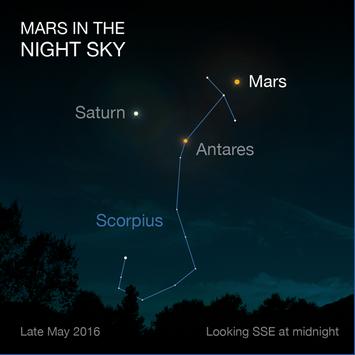
From May 18 to June 3, 2016 Mars will be at its brightest. Just go outside and look up (SE) for a bright “orange star” that does not flicker. That will be the “red” planet Mars.
It takes the planet Mars about two Earth years minus 50 days to make its trip about the Sun. Mars appears brightest * in our Earth sky when Earth is in the line between Mars and the Sun. This happens about every other Earth year. Those other years Mars appears dimmer in our sky because at those times Mars and Earth are on opposite sides of the Sun. Some opposition years find Mars and Earth not only on the same side of the Sun, but also in closer proximity. 2016 is one of those years. Enjoy the view!
This year to the unaided eye Mars looks brigher and through a telescope Mars looks larger. Enjoy close-up views of the planet Mars and other wonders of the night sky at the June 10 and 11 Amateur Astronomers Association of Pittsburgh Star Parties scheduled at the Wagman Observatory and at the Mingo Observatory.
For more information please check back and follow us on Facebook, via the button below.![]()
Respectfully submitted, Kathy DeSantis.
*Brightness in the case of a planet depends upon to a number of factors: size, distance, ability of the planet’s surface and/or atmosphere to reflect sunlight, geometric location relative to the sun and earth, lunar transits. In this apparition Mars appears brighter because it is both at opposition and it is also closer. Opposition refers to the geometric relationship with the Sun and Earth. The decrease in the distance between Mars and Earth at different oppositions occurs as a result of our planetary orbits not being concentric perfect circles and Mars and Earth having different orbital velocities.There are many factors involved and we invite you to visit our Mingo and Wagman Star Parties and ask our helpful staff questions about Mars and other celestial objects and astronomical phenomena.
